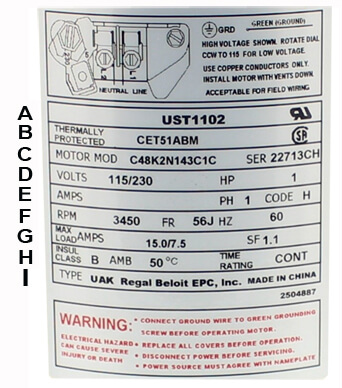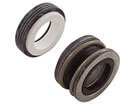FREE Standard Shipping On All Orders $100 or More!*
Swimming Pool Pump Motors Deconstructed
Pool Pump Motors Deconstructed
Pictured below is the capacitor start electric motor, made by AO Smith and others, and used to power centrifugal impellers on pool pumps. Capacitor-Start motors use stored powered to give the motor windings additional power, to start the rotor turning.
When this power is applied to the coils of wound copper (N) that surrounds the rotor (B), it begins to rotate within the stator. The rotor is alternately repelled and attracted, and this quickly ramps up rotor revolutions to over 3400 RPM.

All of the items at the rear of the motor are replaceable, with the capacitor being the most often replaced motor part. Inside the motor, the motor bearings can be replaced if they begin to squeal, although if the motor is over 5 years old, it may be better to replace the motor, in my opinion. Electrical motors are recyclable, and there is some scrap value to the copper windings, if you want to strip them out.
| A. Motor Frame | F. Capacitor | K. Ground Terminal |
| B. Rotor and Shaft | G. Terminal Board | L. End Cap |
| C. Motor Bearings | H. Thermal Overload | M. Stator |
| D. Motor Fan | I. Centrifugal Start Switch | N. Stator |
| E. Support Frame | J. Governor |
Reading a Pool Motor Label

A. This line gives you the model number of the motor, in this case the UST1102. The backwards RU is a UL mark.
B. This line shows that the motor is thermally protected, and then lists the Thermal Overload part number CET51ABM. The CSA logo is the Canadian Standards
C. MOTOR MODel number is used when replacing a motor, to get one with the same electrical construction. Serial Number? Not that useful; it just tells when it was made.
D. Line D shows the Volts 115/230, meaning this motor has reversible power, or can accept either. HP stands for Horsepower, in this case 1.0 hp.
E. AMPS is listed further down. Also on line E is PH for Phase, single phase in this case. CODE refers to the NEMA classification for motors.
F. RPM - revolutions per minute, 3450 for pool motor types. FR - Frame type, in this case a 56J. HZ stands for Hertz, 60 hz in the US and 50 Hz in other parts of the world. VS motors have adjustable, or Variable Speeds, from 600 to 3450 RPM.
G. Max Load Amps lists two numbers 15.0 / 7.5. The first number is max amps used when wired 115V, and the second number is amp draw for a 230V hookup. SF stands for Service Factor, and this tells if the motor is uprated, or max-rated. The SF number is multiplied by the HP number to compute total horsepower.
H. Insulation Class B is used for most spa and pool motors, AMB lists the maximum ambient temperature this motor should operate in, 50° Celsius, or 122° Fahrenheit. Time Rating of CONT means that this motor is made for Continuous Duty, or built to run all the time, if needed.
I: Motor TYPE is used to tell the type of motor used - CS for Capacitor Start, or UAK for Capacitor Start/Capacitor Run. The manufacturer Regal Beloit is listed and the country of construction, in this case China, is listed.
How to Select a New Pump Motor

The first thing you need to know is what Frame type you have. 48Y is often called square flange, 56J is often called C-flange and 48 frame are used on spas and above ground pool pumps. After that you want to match Horsepower, and Service Factor in particular. You can also use the model number to locate a replacement pool pump motor.
You cannot Increase the horsepower of your motor, unless you also buy a new impeller. Each horsepower has its own impeller, and Full-rated and Up-rated also have different impellers. It is always best to install an exact replacement motor.
If you really must have a bigger pump, it can be simpler to buy a new pump, rather than installing a larger motor, seal and impeller. And, please be sure your system can handle more power. Installing a pump that is too large for the system (pipes, filter, valves), can cause problems.
For help selecting a new motor, please feel free to contact our call center at 800-288-7946, or Leave a Reply below, with all the information on your motor name plate, and the make and model (and horsepower) of your current pump.
What is the difference between Full-Rate and UP-Rate Motors?

An Up-rated motor (aka Max-rated), is when a motor is modified to have a higher Service Factor (SF), which increases the total horsepower (THP) of the pump. So, an uprated 1.5 hp pump for example, is a 'juiced-up' 1-hp motor, with a higher Service Factor, and internal modifications, for a total horsepower of 1.5 hp.
A full-rated 1.5 hp pump will produce higher flow rates and higher pressures than an up-rated 1.5 hp pump, which will have actual flow characteristics closer to the 1.0 hp model. Up-rated pumps produce less flow as the same horsepower full-rated models, but they also consume less energy and cost less to buy.
What's in the Rear of the Motor?

12 o-clock: Thermal Overload Switch, a hi-limit that shuts off the pump if it gets too hot, turns pump back on once cool.
3 o-clock: Terminal Board, connect your two incoming power leads here, does not matter which wire goes to which screw. Ground to green screw.
6 o-clock: Stationary Switch, the switch opens when the motor reaches 3450 RPM, to disengage the capacitor power.
9 o-clock: Capacitor is the starting battery for the motor, kind of like your car battery, to provide an assist when starting the motor.
Center: Governor, aka Centrifugal Switch, screwed onto the end of the shaft, is a spring loaded device that lays flat when 3450 RPM is reached, which opens the Stationary Switch, and cut off power from the Capacitor.

Can Pool Pump Motors be Rebuilt?

When we talk about a 'motor rebuild' for a pool pump, we're talking about new bearings (front and rear), and a new shaft seal (which is technically a pump part).
Nobody would bother with larger motor repairs on residential pool motors, so if there is a short across the windings, or if the shaft is unbalanced, or the fan vanes broken, that motor is DOA, when brought to a motor shop.
Yes, you can "pull the motor" and drive it over to a local electric motor repair shop, and they will rebuild it, with new bearings and seal, and also inspect, clean and tighten, and maybe even a fresh coat of paint. $100-$150. You can usually pick up your rebuilt motor the following day.

You can also rebuild your own motor, with a pair of bearing pullers and the correct set of front and rear motor bearings, and the right shaft seal. You can also find all of your seals and o-rings for the most popular pool pumps, available in our ready to go pump rebuild kits.